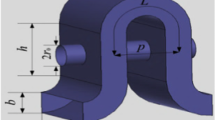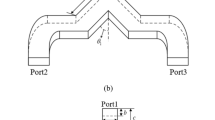Abstract
At high average power level, waveguide-based structures are indispensable in microwave systems due to their higher power handling capacity. These structures are often used to perform power division and combination operation. Folded H plane tee is one of the many components that can be used for the power division application. Its advantage is that the output arms and input arms are in a single plane along a single axis, thus taking less space in the overall system. However, their proper thermal management is indispensable for its use, as high surface temperature of the waveguide reduces its power handling capacity at high power level. This paper presents quick, easy design steps and methodology for obtaining the structure of a folded H plane tee at any given frequency of operation. Further, a scheme for the thermal management for high input power level (500 kW continuous wave) is presented. The proposed methodology is tested at various frequencies in COMSOL Multiphysics, CST Microwave Studio and HFSS with excellent results. A prototype structure was fabricated for use at 3.7 GHz, which exhibited good agreement with the simulation results.










Similar content being viewed by others
References
Hillairet J et al 2011 RF modeling of the ITER-relevant lower hybrid antenna. Fusion Eng. Des. 86: 823–826
Hillairet J et al 2012 Lower hybrid antennas for nuclear fusion experiments. In: Proceedings of the 6th European Conference on Antennas and Propagation (EUCAP), Prague, pp. 1–4
Ekedahl A et al 2011 Long pulse operation with the ITER-relevant LHCD antenna in Tore Supra. AIP Conf. Proc. 1406: 399–406
Ridolfini V P et al 2004 Experimental test of an ITER-like passive active multijunction lower hybrid RF launcher on the FTU Tokamak. In: Proceedings of the 31st EPS Conference on Plasma Physics, London, vol. 28G, p. 2.105
Olivier J C and McNamara D A 1992 Analysis of multiport rectangular waveguide devices using pulsed finite-difference time-domain (FDTD) technique. Electron. Lett. 28(2): 129–131
Panda D K and Chakraborty A 2008 Analysis of folded H-plane tee junction using multiple cavity modeling technique. In: Proceedings of the IEEE Region 10 and the Third International Conference on Industrial and Information Systems, vol. 214, pp. 1–6
Yang S and Fathy A E 2009 Design equations of arbitrary power split ratio waveguide T-junctions using a curve fitting approach. Int. J. RF Microw. Comput. Aided Eng. 19(1): 91–98
Marcuvitz N 1951 Waveguide handbook. New York: McGraw-Hill Book Company
Ragan G L 1948 Microwave transmission circuits. New York: McGraw-Hill Book Company
Pozar D M 2009 Microwave engineering. Hoboken: Wiley
Acknowledgements
We thank the Board of Research in Nuclear Sciences-Plasma and Fusion Research Committee (BRNS-PFRC) for supporting the project with Grant [39/02/2015]. We would also like to thank P R Parmar and the workshop team at Institute for Plasma Research, Gandhinagar, for all the support extended for fabricating the structure.
Author information
Authors and Affiliations
Corresponding author
Rights and permissions
About this article
Cite this article
Dixit, H.V., Jadhav, A.R., Jain, Y.M. et al. Design data for quick development of folded H plane tee at high average power level. Sādhanā 43, 33 (2018). https://doi.org/10.1007/s12046-018-0819-9
Received:
Revised:
Accepted:
Published:
DOI: https://doi.org/10.1007/s12046-018-0819-9




